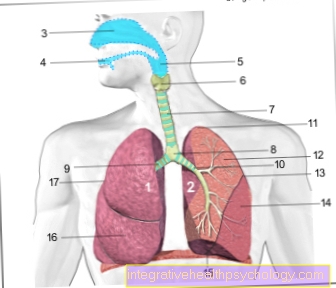What are the chances of survival with a pulmonary embolism?
introduction
Multiple factors play a role in the chances of survival after a pulmonary embolism. Particular emphasis should be placed on immediate medical care after an embolism, as this significantly improves the chances of survival regardless of the severity of the disease. Of course, the size of the pulmonary embolism also plays a role.
The following rule of thumb applies here: the larger the embolism, the worse the chances of survival. Anyone who has pre-existing conditions in the lungs, heart or circulatory system also has poorer chances of survival than an otherwise perfectly healthy person.
Read more on the topic: Causes of Pulmonary Embolism

What is the chance of survival after a pulmonary embolism?
The chances of survival after a pulmonary embolism depend on the one hand on the severity of the embolism; on the other hand, other pre-existing diseases, particularly in the cardiovascular system, also play a role.
The pulmonary embolism is divided into three degrees of severity, which make a statement about the premature mortality after the embolism.
A low risk (less than 1%) is present when the circulatory system is not stressed, the laboratory values show no signs of heart damage and the blood clot that caused it can be removed quickly. The pulmonary embolism triggers here are mostly small to medium-sized thrombi (clots).
One speaks of a medium risk if the premature mortality is 3 to 15%. In these cases the heart is affected by the pulmonary embolism. The laboratory tests either show increased troponin values or a dysfunction of the right ventricle is found. In this case, treatment must take place in the hospital so that long-term damage can be counteracted at an early stage.
The highest degree of severity is associated with an early mortality of over 15%. The circulatory system is directly affected by the pulmonary embolism. This manifests itself as a state of shock or extremely low blood pressure. Here, the blood clot must be removed immediately using blood thinners or surgery.
You might also be interested in: Treatment of pulmonary embolism
Chances of survival in a fulminant pulmonary embolism
The fulminant pulmonary embolism describes the embolism in its most severe form. Fulminant means that the embolism occurs very suddenly and is followed by a very rapidly progressing and critical course.
The premature mortality here is over 15%. A fulminant pulmonary embolism usually leads to life-threatening complications such as cardiac arrest and subsequent heart failure (cardiac insufficiency). Depending on how quickly the embolism and the complications can be treated, the mortality rate increases to over 50%.
You might also be interested in: What are the consequences of a pulmonary embolism?
Chances of survival in a bilateral pulmonary embolism
A bilateral pulmonary embolism is usually fulminant, as the entire vascular system of the lungs is affected. Because all vessels are blocked, there is no longer any oxygen supply.
Above all, this has consequences for the lungs, heart and brain. In addition, the heart is very badly affected because it has to pump against an infinite resistance in the pulmonary vessels. This leads to cardiac arrest within a few minutes.
Immediate resuscitation is necessary to ensure any chances of survival. In addition, the triggering thrombus (blood clot) must be removed very quickly. Since the heart is usually badly damaged (heart failure / cardiac insufficiency), long-term survival is also strongly affected.
Which conditions positively influence the survival rate?
The smaller the pulmonary embolism, the better the chances of survival.
In addition, a young age and as few previous illnesses as possible offer a particularly favorable prognosis. If there are no lung or cardiovascular diseases, the chances of survival are very good.
Thrombosis prophylaxis also has a major influence on the chances of survival, because anyone who has once had a pulmonary embolism is more likely to have another blood clot in the lungs. Therefore, those who exercise regularly and wear compression stockings when risk factors are present have very favorable conditions.
Physical fitness has a positive influence on the chance of survival not only because of the reduced risk of thrombosis. In addition, a fit person has better capacities to compensate for the consequences of a pulmonary embolism. This can significantly improve and accelerate the recovery process after a pulmonary embolism.
People who already suffer from previous illnesses can improve their prerequisites by having these illnesses controlled well with medication. Coagulation disorders, high blood pressure and metabolic diseases such as diabetes (blood sugar disorder) and an imbalance in blood lipid levels can be influenced extremely positively with appropriate medication and a healthy diet.
You might also be interested in: How can you recognize a pulmonary embolism?
Which factors negatively influence the chances of survival of a pulmonary embolism?
Factors that negatively affect the chances of survival after a pulmonary embolism affect the embolism itself, on the one hand, and previous illnesses of the person concerned must also be taken into account.
The following principle applies to pulmonary embolism: the larger the embolism, the more unfavorable the prognosis.
Pre-existing conditions that negatively affect the chances of survival are, on the one hand, all types of lung diseases. These include previous pulmonary embolisms as well as chronic diseases (COPD = chronic obstructive pulmonary disease, asthma, chronic bronchitis, etc.). Recurring respiratory diseases or lung cancer are also bad conditions.
In addition, existing heart diseases have a negative influence on the chances of survival. Since pulmonary embolism often also affects the heart, heart failure (cardiac insufficiency) is a negative prognostic factor. A heart attack that has already taken place, a coronary heart disease or a disease of the heart muscles is also to be rated as negative. Other risk factors for a negative prognosis are additional diseases such as high blood pressure, diabetes (blood sugar disease), poor blood lipid values, etc.
How can you improve your chances of survival?
If you want to improve your chances of survival after a pulmonary embolism, you should first make sure that you are taking blood-thinning agents. After a pulmonary embolism, the chances of getting another embolism are significantly increased.
Therefore, blood thinners should definitely be taken for at least a few months. Rapid mobilization also has positive effects, as physical activity counteracts the development of a new thrombosis (which can subsequently trigger a pulmonary embolism).
Furthermore, other diseases that are already present should be well adjusted to improve the chances of survival. Specialists should be consulted for the respective pre-existing conditions so that the various therapies can be coordinated well. For a good long-term prognosis, it is also advisable to be physically active. This improves lung function and circulation, and the cardiovascular system is also strengthened. In this way, future events can be avoided or at least better compensated for.





























